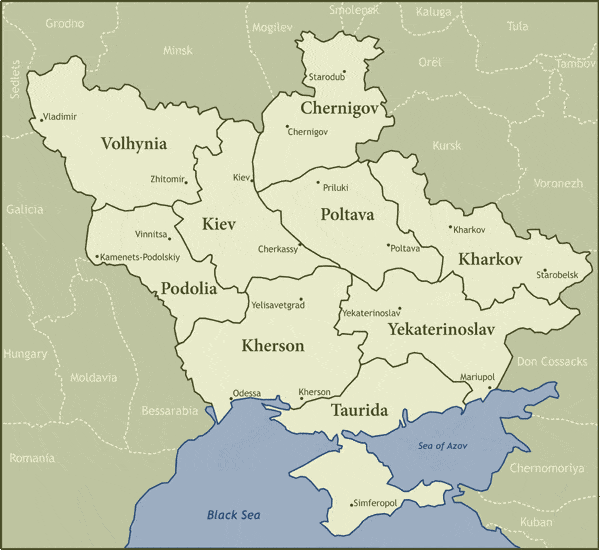Sokolivka: Once Home
Locating Sokolivka
Introduction
The Jewish community of Sokolivka formed in the second half of the 18th century in what is present day Ukraine and was then part of the vast Russian Empire. By 1765, there were around 585 Jews in Sokolivka and the surrounding villages. Over the decades the population grew, so that the small village became predominantly Jewish.
In 1825, however, Czar Nicholas I in a series of anti-Jewish measures, issued a law restricting the rights of Jewish residency within certain places based on land ownership. Jews who did not own land in certain areas were forced to move and this became the fate of Jews in Sokolivka. A couple of Jewish families already lived less than a mile away, across a bridge and it was there that the many of the 35 Jewish families affected by the ukase (edict) took up residence, initially camping in outhouses and fields. This land was owned by a landowner and his wife called Justina. She offered to sell some land in order to creating a new settlement. The families named the place of their new settlement Justingrad in her honor, pronounced it Ustingrad in Yiddish.
A place of many names
Sokolivka has many spellings in different languages. Today it is most often referred to by its Ukrainian name, Sokolivka, so it can be found on maps, but former residents and descendants have used this name and many other ones. We are following this practice too, using several forms interchangeably, as used by the historical organizations in their own documents that changed over time, as well as names used by families, understanding that variations sometimes relate to different language transliterations, as well as historical and personal practice and preference.
Variant Spellings
Yiddish: Sokolifke, Sokolievka, Sukeliefki, Sokolivka
Ukrainian: Sokolivka
Russian: Sokolovka
Polish: Sokolowka, Sokoluvka
Variations also exist for “Justingrad”, including Yustingrad, Justynhrad and Ustingrad.
Ustingrad is used by Sokolivkers/Sokolifkers for the social and benefit organization formed in 1913 in Buffalo: Ustingrader Unterstitzung Verein.
In Justingrad: Sokolivka in Our Hearts
While most Sokolifkers are descended from families who lived in Justingrad rather than Sokolivka, they still thought of themselves as Sokolifkers. By the 1890s there was a well established Sokolifke population in Justingrad of over 2,500 Jews. Within 30 years, however, less than half remained, and by 1939, only 150 Jewish Sokolifkers were resident in Justingrad. On July 1941, the village was occupied by the Nazis and the remaining residents were deported or murdered, as the village and surrounding communities were systematically destroyed.
Maps
sokolivka was Located in the western Kiev Region, in the Russian Empire, in 1910
Map featured on JewishGen, permission for reproduction by Nolan Altman of JewishGen.
Sokolivka-JUstingrad, 1846
Justingrad is circled in red, on the edge of Sokolivka over the river. Map usage permission of Chaim Buryak, moderator of website: Ukranian Jewish History.


